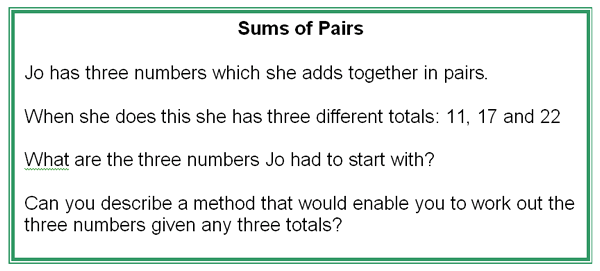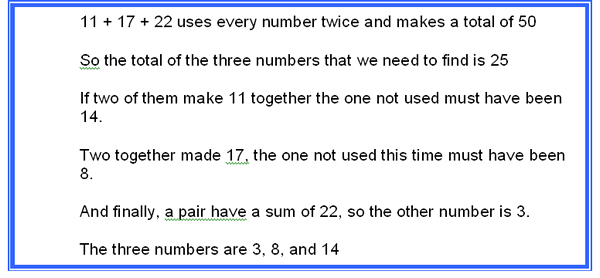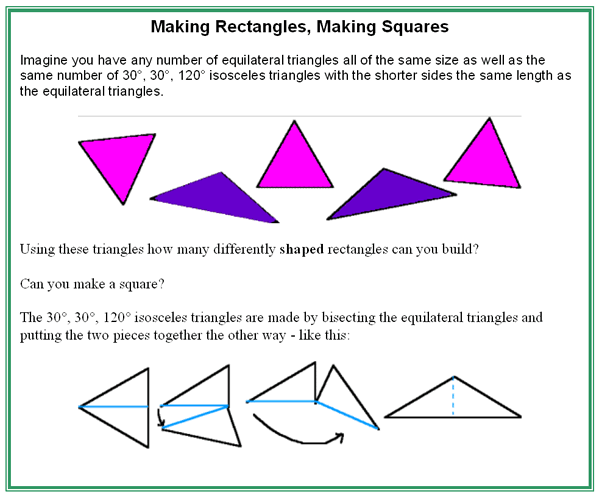Copyright © University of Cambridge. All rights reserved.
'A Problem Is a Problem for All That' printed from https://nrich.maths.org/
Show menu
This article was first published in The Scottish Mathematical Council's Journal (2008), Vol 38, P54-57.
Often, when I start a problem-solving session I begin by saying something like:
"Today we are going to be problem solving and this means working on problems. So, before we start it might be good to know what I mean by a problem. A problem is something that you probably will not immediately see how to tackle or which once started will challenge your thinking. This means that at some point you are likely to get stuck and this is OK. In fact it is important that you get stuck so that we can talk about possible ways of getting unstuck."
In other words the very problem with problems, namely that they should result in you being stuck, is at the heart of what problem solving is about. This contrasts strongly with most classroom experiences of learners when being stuck is equated with failure. In this article I am going to talk about just a few of the other problems with problems that make them such a rich source of mathematics and approaches to learning mathematics.
Of course, I have immediately set myself a problem because whatever 'problems' I select for us to work on here, they will not necessarily be problems for all of you. They may not challenge you all (especially if you have seen them, or questions like them, before and therefore you know what to do and do not get stuck). I will do my best to identify good problems that offer interesting insights and the rest is up to you. So, in discussing what the problem with problems might be, I will try to select examples that will engage you and extend your thinking and perhaps even surprise you. Even if you have seen a problem before and think you 'know it', I challenge you to ask yourself "What next?" or "What if?" or "Do I really know all there is to be known about this problem?" or "Can I learn more?".
So this article is as much about doing as reading. In the true spirit of problem solving though, I am trying to seed some ideas and leave you to try things out and refine your own thinking. I cannot be sure where you will end up but I have some sense of the story I am trying to tell, and that is about some of the problems that arise from working with problems and how these are all part of being mathematical.
Time and Tide
So, let's start with a problem - Big Powers :

Have you seen something like this before?
Do you immediately know what to do?
Are you fairly confident you can quickly find the answer?
If your answer to two or more of the above is "Yes", as it stands, this is probably not a problem for you and you should ask some of the questions that extend your thinking (for example: What if it wasn't 3 and 4? Can you generalise? Can you prove ...?).
If you are not certain what to do, spend some time thinking about this problem. Make yourself a cup of tea, relax, take your time, as you can always come back to the article later.
If you had no idea where to start, what strategies did you adopt or did you just give up and decide to read on?
A colleague of mine walked past this problem for nearly a year. It took him this long before the penny dropped and it 'suddenly' went from being a problem to not being a problem. So what, if anything, happened over that year? I would say lots. My colleague allowed himself all the time he wanted to pull all those ideas and issues hiding in metaphorical cupboards together. There was no pressure. No one was testing him. There were no time constraints.
I hope you are thinking how similar to the classroom this isn't.
So, one problem with problems in the classroom is time. I do not mean the time to fit problem solving into the curriculum but the time to go about the activity of problem solving. What strategies can we bring to bear to deal with this? Well the first thing I am tempted to say is 'give your pupils time' and allowing 'having time' to be part of their mathematical experience seems important. Another colleague on the NRICH team talks about 'pot boilers'. If one lesson is not long enough to get focussed and thinking, how about introducing a problem or idea in one lesson and keep on popping back to see how it is doing? (Has anyone had any ideas since we last looked at this?). We should welcome things that are left stated but untried, started but not finished, finished but in arriving at a solution raise more questions. Why not have a 'pot boiler' always on your classroom wall and come back to it every so often to see if anyone has had any ideas. This is basically what my colleague did with Big Powers.
Another strategy related to time might be to work on things more collaboratively but with the pupils working on the problem together with your support. That is, they come up with ideas that you help them share, stopping occasionally when a new discovery or step has been made to highlight the progress for all. One strategy that might be useful here is to encourage learners to share their ideas with the class, facing the class, rather than addressing them to you as the teacher, and asking the group to feedback, comment or ask further questions.
What I am not advocating is breaking the problem down and taking the learners step by step through the journey. Perhaps if they cannot suggest, with your support, possible approaches and strategies and you want them to move on quickly it was not a 'good problem' and best left for the moment. What will they learn by simply being told what to do? If they do learn something it is difficult to see what it has to do with problem solving so what was the point? Why not make it a pot boiler?
Implicit in what I have been saying, but not yet stated, is that problems take longer. Learners will inevitably spend longer on each question that is set. In doing so, learners are given time to engage in and own the mathematics rather than learning a method that is easily forgotten and rarely applied.
So one issue is definitely time, but this is a good problem to have to work with. Many teachers I meet say that they wished their pupils would not give up so easily, would persevere and spend longer trying harder and not demanding to know what to do or what the answer is. What better way to encourage a change in such attitudes?
Same but Different
Now spend some time thinking about the following problem, called Sums of Pairs before reading on:

I remember a session when one of my colleagues was working with a group of Year 10 pupils. In the session the pupils worked in small groups trying to solve the problem. Probably, like me, your first approach might be by using algebra but what was interesting was the different approaches the pupils adopted in order to find a solution. For example:
- some learners used an algebraic approach (calling the original three numbers a, b and c)
- others used trial and improvement. One of these groups starting by saying that the smallest number has to be $8$ or less in order to make a total of $17$ (why?) ...
- another group of pupils found a solution almost 'by accident', a set of random attempts result in unexpected success. At that point my colleague gave them a similar problem to encourage them to search for a method that they could generalise.
After some time the pupils were encouraged to share their
methods and then to discuss approaches they found most accessible,
repeatable and efficient. Great value was being placed on
creativity, as differences in approaches were described, valued and
assessed. This formed a key part of the learning process. It was
the means by which the pupils made their journeys towards a
solution rather than the solution itself which was being
valued.
Everyone was encouraged to listen to, and learn from others.
Of course, pupils needed to be confident enough to communicate with
and to their peers and come to their own views. This takes time and
practice but is achievable if pupils are used to working in this
way and given lots of opportunity to practise.
In this case the problem with the problem is the lack of
'control' of the way it was tackled. But this is its main strength.
In fact I don't think the algebraic approach is the most elegant in
this case and one of the
solutions on the website is as follows:

I think that is so neat and not at all the way I thought of it. I certainly learnt a lot and what a useful idea to store (partial sums). Now you may have done it this way, but watching the approaches adopted by the pupils may have offered you something different, not least the way they engaged in each other's methods.
Perhaps I should end with just one more thought, leaving room for plenty of other problems to be investigated later!
Outcome Versus Journey
I have mentioned earlier the importance of the journey and sometimes there is a balance to be struck between letting go and wanting a particular outcome. A problem that comes to mind in this respect is Making Rectangles, Making Squares :

I use this problem a great deal but I never start from the question given, and only once or twice have the group I have been working with answered the question as set. This is because so much other rich mathematics arises naturally from discussion that I find it a shame to let it go. Also, by inviting learners' own ideas the problem offers me an opportunity to assess their knowledge as well as their ability to pose their own problems. At one level, it is possible to discuss proof, use rational and irrational numbers, as well as utilise Pythagoras' theorem. At other levels you might find yourself exploring symmetry or triangle animals (all possible shapes made from $2$, $3$, $4$ ... triangles that are joined by common sides). It links to a number of other problems on the NRICH website site including Triangle Relations and Equal Equilateral Triangles .
The tension for me is always about balancing the original intentions of the problem with what the learners are telling me in terms of their own understandings. In general I tend to use the context, rather than the problem itself, as a starting point for encouraging learners to see the mathematics in a situation and to pose their own problems.
So how might this happen? Perhaps if I relate how I have used this problem, things will be clearer. Firstly, I just hand out the triangles without any indication of how they are related or formed. Working in small groups the learners 'play' with the triangles for a few minutes and write on large sheets of paper (to share with the rest of the group) what they consider to be four key mathematical properties of the triangles.
The class is then invited to walk around the room and look at what other groups have written. At this point they can add anything else they feel is important to their list. Discussion as a whole group reveals what they were most 'surprised' by or intrigued by as they walked around and what they might like to investigate further. It is normally at this point we talk about the relationships between the two triangles- including things like their equal areas.
By now many of the learners are coming up with problems of their own, although not yet fully articulated:
"The two triangles can be put together to form a right-angled triangle. Can we make right-angled triangles any other way?"
"Can we make a square?"
"Can we make a rectangle from just one colour?"
"What sized equilateral triangles can we make?"
"Can we make the same sized equilateral triangle in just red or just green triangles?"
"What symmetrical shapes can we make?"
The list is almost endless but it is at this point I have to make a decision; whether to encourage the exploration of different areas of interest or bring the focus of the lesson in on a particular idea. I could for example, pick up on the first three questions posed and suggest an exploration of the problem posed on the site. There is a great range of possibilities around equilateral triangles and hexagons and, of course, there are all the problems based on symmetry (for example, how many different symmetrical shapes can you make with just four triangles?). I remain very flexible and tend only to go in a particular direction, such as squares and rectangles, if it has appeared naturally out of earlier group discussions from several of the groups. My rationale for this is that if the groups have not seen the connection naturally they may not be ready (though I do make efforts to extend thinking as the groups work).
I know that we often use a problem to bring out a certain aspect of mathematics, and when this is the case a certain amount of classroom choreography is needed to provide a level of steer in the intended direction. However, with this problem I am rarely using it for the sole purpose of discussing rational and irrational numbers, surds and Pythagoras' theorem. I have been delighted when these ideas have come out of the problem but basically my interest is in the process of seeing the mathematics in the situation and posing some problems, so the rest is just a bonus. Letting go is the key requirement but the invitation to play and write ideas offers an excellent opportunity for assessment too!
In Closing
In the end a problem is as good as we make it. There is a requirement for patience, flexibility and allowing time to think and share. But that is what mathematicians do. In fact that is what we all do when we are stuck. We take a break, go and make a cup of tea and even talk to a friend. We make sense of situations at levels we can understand and then learn a little more by doing. I think this can be summed up by saying:
- Give learners space
- Value their differences
- Learn from what they do and help them to make connections
- Use the inherent richness of opportunities to highlight interesting mathematics